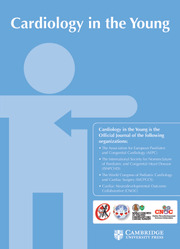No CrossRef data available.
Article contents
Maternal exposure factors in pregnancy that affect fetal CHD risk: a case–control study
Published online by Cambridge University Press: 19 May 2025
Abstract
We sought to assess the degree to which environmental risk factors affect CHD prevalence using a case–control study.
A hospital-based study was conducted by collecting data from outpatients between January 2016 and January 2021, which included 31 CHD cases and 72 controls from eastern China. Risk ratios were estimated using univariate and multivariate logistic regression models and mediating effect analysis.
Residential characteristics (usage of cement flooring, odds ratio = 17.04[1.954–148.574], P = 0.01; musty smell, odds ratio = 3.105[1.198–8.051], P = 0.02) and indoor total volatile organic compound levels of participants’ room (odds ratio = 31.846[8.187–123.872, P < 0.001), benzene level (odds ratio = 7.370[2.289–23.726], P = 0.001) increased the risk of CHDs in offspring. And folic acid plays a masking effect, which mitigates the affection of the total volatile organic compound (indirect effect = -0.072[−0.138,-0.033]) and formaldehyde (indirect effect = −0.109[-0.381,-0.006]) levels on the incidence of CHDs. While food intake including milk (odds ratio = 0.396[0.16–0.977], P = 0.044), sea fish (odds ratio = 0.273[0.086–0.867], P = 0.028), and wheat (odds ratio = 0.390[0.154–0.990], P = 0.048) were all protective factors for the occurrence of CHDs. Factors including women reproductive history (history of conception control, odds ratio = 2.648[1.062–6.603], P = 0.037; history of threatened abortion, odds ratio = 2.632[1.005–6.894], P = 0.049; history of dysmenorrhoea (odds ratio = 2.720[1.075–6.878], P = 0.035); sleep status (napping habit during daytime, odds ratio = 0.856[0.355–2.063], P = 0.047; poor sleep quality, odds ratio = 3.180[1.037–9.754], P = 0.043); and work status (working time > 40h weekly, odds ratio = 2.882[1.172–7.086], P = 0.021) also influenced the CHDs incidence to differing degrees.
Diet habits, nutrients intake, psychological status of pregnant women, and residential air quality were associated with fetal CHDs. Indoor total volatile organic compound content was significantly correlated with CHDs risk, and folic acid may serve as a masking factor that reduce the harmful effects of air pollutants.
Information
- Type
- Original Article
- Information
- Copyright
- © The Author(s), 2025. Published by Cambridge University Press
Footnotes
These authors contributed equally to this work.


